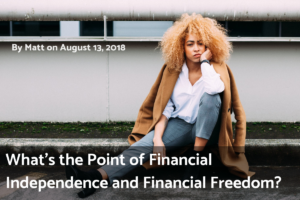Listen on iTunes. Listen on Google. Listen on Stitcher.
Financial emergencies happen to all of us and we know that. When and how those emergencies happen is another story. An unexpected visit to the emergency room or a major car repair can happen anytime and you want to make sure that you are prepared financially as much as possible. This is why a fully funded emergency fund is a critical must in helping you maintain your financial independence and sanity.
We started maintaining an emergency fund in 2017 and and will keep one for a very long time. I personally like the idea of having liquid cash available at a moment’s notice and not having to rely on borrowing the money. There are a lot of arguments for and against having an emergency fund, but I personally feel that having one can only be positive for your financial goals. Let’s get into some of the reasons and strategies of fully funding an emergency fund and how this will help fully fund your mission to achieve financial independence.
1. Peace of Mind
There’s no doubt having money available for the “just-in-case” moments takes some stress away. You don’t have to think or spend time working to pay for an emergency. Thanks to the easily accessible emergency fund you are in a much better position to deal with any financial problems that may come up. You can rest peacefully at night knowing that whatever the market does you will always have a safe place to keep your money that can only go down if you make withdrawals.
2. Quick Access of Emergency Fund
One of my favorite benefits of having a fully funded emergency fund is the ease of accessing the money when needed. We keep our money in an American Express High Yield Savings account. This account allows for 6 transfer per month. This way I don’t have to worry about waiting a few days to get this money from taxable accounts or sell investments. I can get what I need immediately and let my money in investment accounts continue to grow.
3. High Yield Savings Account
One of the challenges with keeping money outside of stock/bond investments is keeping up with inflation. Typically inflation is about 3% per year and having stocks and bonds helps you keep up with that. With high yield savings rates of 1.3% to 2% you won’t be able to keep up with inflation, but the value of your emergency fund will never decrease. That’s the key. Our emergency fund sits in an American Express high yield savings account that pays 1.8-1.9% interest currently in November 2018. This isn’t a lot obviously when you compare it to a total market index fund, but it’s good enough to support the goals of an emergency fund. Besides an emergency is not an investment so I don’t recommend it be more than 5% of your net worth.
*Update as of January 29, 2019 American Express offers 2.10% on their high yield savings accounts. Ally offers 2.20% and those are two great high yields savings accounts you can use.
4. FDIC Insured
There’s nothing more reassuring than knowing that your money in a savings account will always be there. That’s basically what FDIC (Federal Deposit Insurance Corporation) insured means. FDIC insures up to $250,000 and believe it or not, no customer has ever lost any money of insured deposits in the history of the FDIC. Where else can you get a 100% guarantee that your emergency fund will never lose a penny and still grow at the same time? Even if it’s marginal growth, remember an emergency fund is to support the urgent and unexpected situations. And with up to $250,000 FDIC insured you really should have no reason to simply park some money in an account that has the backing of the FDIC.
5. No Volatility
One of the most argued points against keeping your emergency fund in a money market or high yield savings account is the small growth it experiences. Well, obviously the expectation is not for the emergency fund to have a 40-year annual return of 7, 8, 9 or 10%. The expectation is for the money that’s in there to be there no matter what the market does. Some years the investments you have in taxable and tax-advantage will be up and some years they will be down. I’m not sure how comfortable you are with that type of change happening to your emergency fund. Plus, having an emergency fund of 1 year or more could be a powerful hedge against seriously bad market times. Just google “longest U.S. bear markets” and you’ll find articles like this one from The Balance. Undoubtedly, the markets have always recovered in strong ways, but to have 19 months where you’re seeing investments go down in value as much as 50% can be hard to digest for some of us. Having an emergency fund can be a big psychological boost to help you during those down times in the market.
Emergency Fund Size?
This is a debate that many like to have. I would say at least 3 months of funding is a reasonable emergency fund size for basically anyone in the Habesha Finance community. This means you’re able to pay your mortgage, bills, and any other financial obligations for a minimum of three months. Personally, I’d like a year’s worth of expense sitting in a money market or high yield savings account. I don’t mind if it’s earning only 1-2% interest. Having $60,000 of emergency money in an account yielding 2% per year earns you about $1,200 per year. Having the maximum $250,000 that is insured yields about $5,050 per year or $420/month.
Remember a fully funded emergency fund is not a place to invest your money. And really your emergency fund should only be about 3-5% of your overall net worth unless you just have millions and millions. As long as you can keep a modest lifestyle and follow the 4% rule then there’s no need for an emergency fund really.



